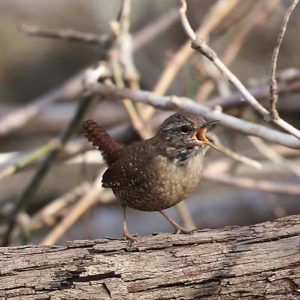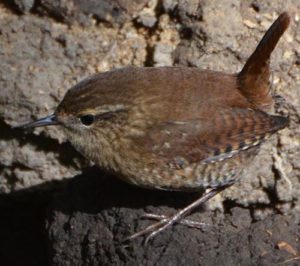When we hear the word “wren,” many of us picture the Carolina wren because it is found year-round throughout most of the eastern U.S. and is such a vocal and animated bird. However, the Carolina wren isn’t our only wren.
Besides the Carolina wren, we have four other species of wrens in the eastern half of North America. Two of those species are found throughout most of the region during at least part of the year. The other two species have more restrictive ranges in the eastern U.S. The winter wren (Troglodytes hiemalis) is one of the two species that are found throughout most of the eastern half of North America.
Basic biology and life history of the winter wren
The winter wren is our smallest species of wren. It primarily eats insects, millipedes, spiders, and other organisms that fall under the general “bug” category. Winter wrens will also occasionally eat berries or seeds during the winter.
Winter wrens breed and spend the summer in Canada, the northern U.S. (Wisconsin, Michigan, Pennsylvania, New York, Vermont, New Hampshire, and Maine), and in some of the higher elevations of the Appalachian Mountains. Male winter wrens arrive on the breeding grounds and establish territories early in the spring. Only the males establish and defend territories.

Each male will build multiple nests within his territory. When the females arrive, the males will begin courting them. After the male has paired up with a female, he will show her the nests that he built. She’ll choose one and then begin lining the nest with feathers and other soft materials before laying her eggs.
Female winter wrens will typically lay five or six eggs. Incubation takes about two weeks and the young chicks will stay in the nest for another approximately two weeks or so before they fledge. The female does all of the incubating. It is unclear how much, if any, assistance the male gives in feeding the nestlings.
After the breeding season, winter wrens migrate south for the winter. Their winter or non-breeding season range extends from northern Ohio, across to Missouri, down through eastern Texas, across the Florida panhandle, and up the coast to Massachusetts. There is a little bit of year-round overlap between the breeding and non-breeding ranges, but most of us have winter wrens for only part of the year.
Note: In 2010, the birds then known as “winter wrens” were split into 3 different species based on genetic and other research. The eastern North American population kept the winter wren name, while the populations in western North America and Eurasia each received a new common. However, the Eurasian wren kept the original scientific name, and both the North American wrens received new scientific names. This can make reading older references about winter wrens a little challenging, especially if they used data from multiple locations because that data could now represent two or three different species of birds.
Where to find winter wrens
During the breeding season, winter wrens are most often found in dense coniferous forests. During the winter, they are often found in more open woods (either coniferous or deciduous) or brushy areas. Regardless of the season, winter wrens seem to have a slight preference for being relatively close to a stream, creek, or other water source, but they can also be found away from such water sources.
Like other species of wrens, winter wrens tend to hang out on the ground or in short, dense bushes. They are often hopping or scurrying along the ground or across downed logs as they look for bugs to eat. Because of their size, coloration, and the way they move, winter wrens are frequently described as looking almost mouse-like as they forage in and out of cracks, crevices, and tree hollows.
How to identify winter wrens
Winter wrens are TINY little wrens – significantly smaller than Carolina wrens. As far as coloration goes, winter wrens are the color of dead leaves with some darker brown barring. They also have a faint buff colored eyebrow like their larger Carolina wren cousins, but not as pronounced. Although winter wrens have the typical “wren tail,” it tends to be relatively short and stubby. I sometimes think it looks like someone cut off part of their tail. Male and female winter wrens look the same.

The way I quickly identify winter wrens is two-fold. First, I see a bird that has the classic wren shape (round body, tail cocked up to the sky) that is way-too-small to be a Carolina wren. Second, I think about where I am and what time of year it is. If it is winter and I’m in or near Kentucky or Tennessee – basically within that central part of the eastern U.S. – then it is almost certainly a winter wren. Winter wrens are the only “little wren” that “should” be here at that time of year. (By the same token, if I’m in that general region and I see a little wren in the summer, then it is likely something else.)
Now, one word of caution. Birds don’t read the books and it is possible for birds to show up in locations or at times of the year when they “shouldn’t” be there. But those are relatively rare occurrences, so I can use where the birds “should” be at different times of the year to help narrow down my choices. Don’t rely on any one factor in identifying a bird, especially ranges. However, it’s much easier to say, “that should be a winter wren,” then see if the bird looks like a winter wren than it is to compare what you are seeing to all of the different species of wrens, even though most of those aren’t very likely.
If you are further north during the summer or further south during the winter, then you may not be able to use my “little wren most likely means winter wren” shortcut. The winter wren will still be your smallest species of wren, but you’ll have to rely more on physical characteristics to narrow down your choices instead of using the bird’s range to shorten the identification process.
Attracting and observing winter wrens
Unfortunately, winter wrens don’t typically visit bird feeders. Therefore, attracting them is going to come down to providing the right types of habitat. For those of us living in the winter wren’s winter range, means doing things like providing brush piles, planting bushes, and not cutting back our native wildflowers in the fall. Winter wrens like to have a lot of cover, so providing those areas of dense vegetation can be very helpful in attracting winter wrens. The good news is that providing the type of habitat which is likely to attract winter wrens is also likely to attract lots of other interesting backyard wildlife as well. So, even if you aren’t able to attract winter wrens to your yard, odds are you’ll still attract lots of other fascinating animals to observe.

Backyard Ecology: Exploring Nature in Your Backyard
Nature isn’t just “out there.” It’s all around us, including right outside our doors. Hi, my name is Shannon Trimboli, and I am the host of Backyard Ecology. I live in southcentral Kentucky and am a wildlife biologist, educator, author, beekeeper, and owner of a nursery specializing in plants for pollinators and wildlife conservation. I invite you to join me as we ignite our curiosity and natural wonder, explore our yards and communities, and improve our local pollinator and wildlife habitat. Learn more or subscribe to my email list at www.backyardecology.net.

Leave a Reply